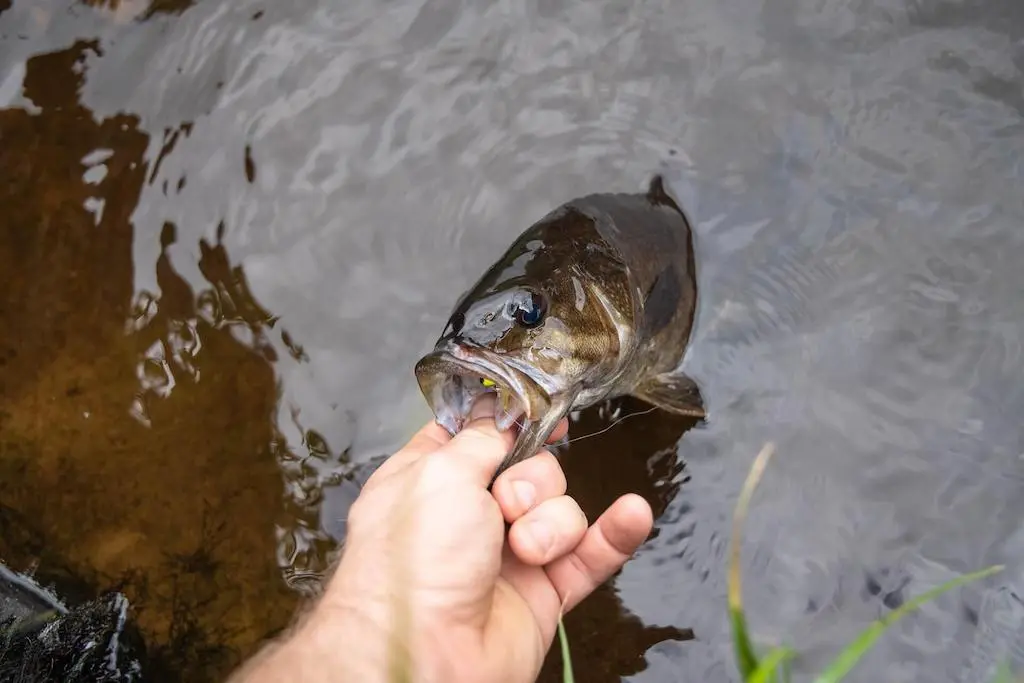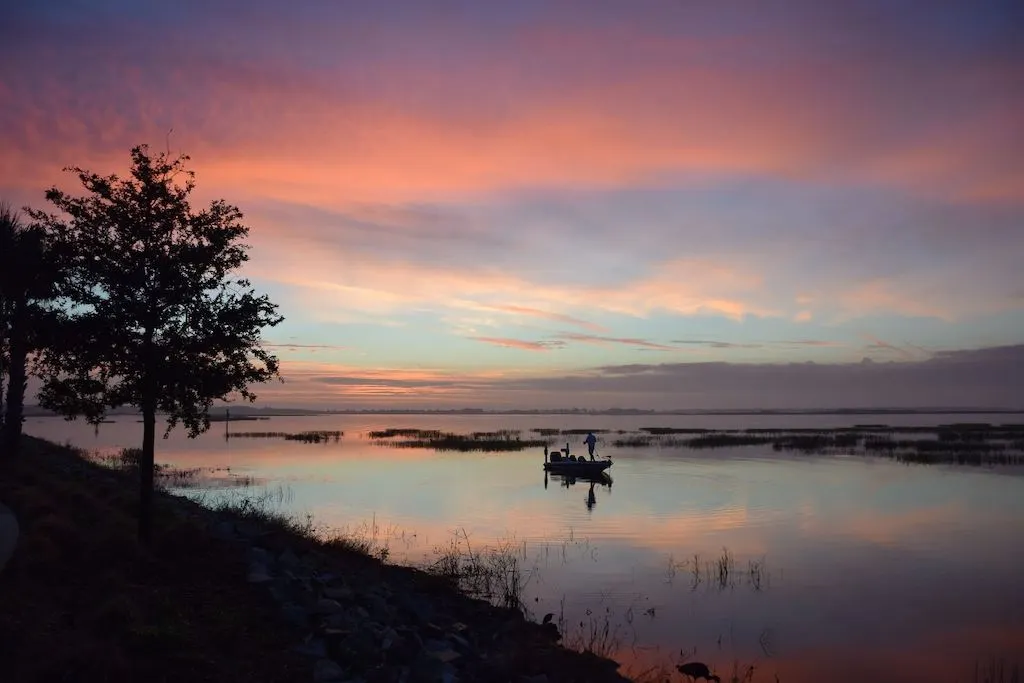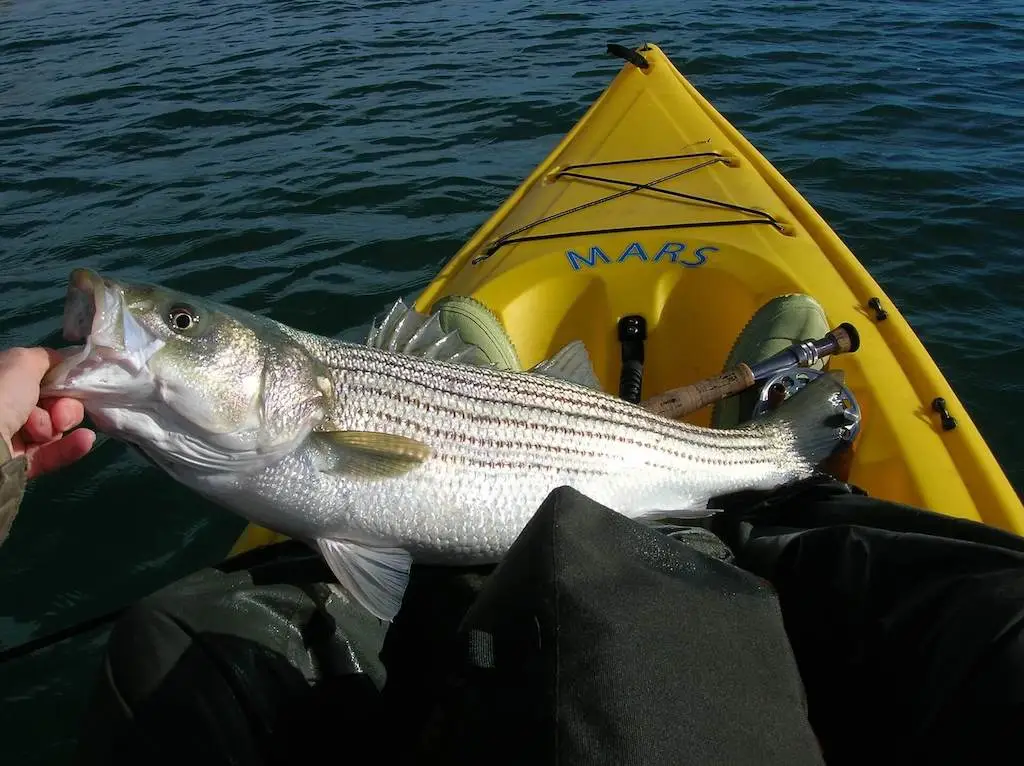Last updated on May 31st, 2023
- What Does Trout Taste Like: Unraveling the Flavor Mysteries - August 2, 2023
- Best Fishing Bibs Tested & Reviewed: Buyer’s Guide - July 19, 2023
- Fishing for Whiskers: Best Bait for Catfish - July 12, 2023
Do you want to catch more bass? Have you been wondering what the best time to fish for bass is? You’re in luck! We’ve done all the research and compiled our findings into this comprehensive guide on when and how to get your hands on some delicious, juicy bass. From finding out which seasons are prime times for catching big ones, as well as which times of day will yield the most results – we have it covered! Keep reading to learn more about smallmouth, largemouth and striped Bass fishing tips that can help improve your next trip.


Table of Contents:
- Best Seasons for Bass Fishing
- Best Times of Day
- Largemouth Fishing Tips
- Smallmouth Fishing Times
- Striped Bass Fishing Tips
- Conclusion
- FAQs
Best Seasons for Bass Fishing
Spring is a great time to fish for bass. During this season, the water temperature starts to rise and the bass become more active. They start to move around in search of food, making them easier to catch. The best times of day during spring are early morning and late afternoon when the sun isn’t too hot. Lures such as crankbaits, spinnerbaits, and jigs can be used effectively during this time of year.
Summer is arguably one of the best seasons for bass fishing due to warmer temperatures that cause an increase in activity among these fish species. Midday tends to be most productive as there is less wind which makes it easier for anglers to cast their lines accurately into deeper waters where larger bass tend to reside. Topwater lures like poppers or buzz baits work well during summer months since they mimic small prey on top of the water surface that attracts hungry predators below.
Fall brings cooler weather but also some exciting opportunities for catching big bass. As temperatures drop, baitfish migrate towards shallow waters near shorelines so it’s important for anglers to take advantage by using lures that imitate these smaller creatures like jerkbaits or swimbaits with slow retrieves along weed beds or rocky areas closeby. Early mornings and evenings provide ideal conditions with calm winds allowing you to make long casts without much disturbance from other boats or people nearby who could scare away your potential catches.
It’s time to get out on the water and start fishing for bass. Spring, summer, fall – no matter the season, there’s always a perfect time to catch ’em. #BassFishing #FishingTipsClick to Tweet
Best Times of Day to Fish for Bass
Morning: Fishing for bass in the morning can be a great way to start your day. The best time to fish is usually right before sunrise or shortly after, when the sun has just started to rise. During this time, the water temperature is still cool and bass are more active. Bass will also feed on insects that hatch during this time of day, so using lures that imitate these insects can be effective.
Midday: Midday fishing for bass can be productive if you know where to look and what techniques to use. Look for areas with shade or structure such as logs, rocks, docks or vegetation where bass may hide from the sun’s heat and bright light. Lures such as crankbaits, spinnerbaits and jigs work well during midday since they mimic baitfish which are most active at this time of day.
Evening fishing for bass is one of the most popular times due to its success rate among anglers. As the sun sets and temperatures begin to drop again, bass become more active in search of food before nightfall arrives. Topwater lures like poppers work well during evening hours as they create noise on top of the water which attracts nearby fish looking for an easy meal.
Heading out for a day of bass fishing? Don’t forget that the best time to catch ’em is in the morning, midday and evening. Get your lures ready and let’s go. #bassfishing #fishinglures #recreationalfishingClick to Tweet


Smallmouth
Smallmouth bass are usually found in clear, cool waters with rocky bottoms. They prefer to stay near structure such as logs, rocks, or weeds that provide cover for them. When fishing for smallmouth bass, it is important to look for areas where the water is deeper than three feet and has a lot of structure.
Lures and Techniques: Smallmouth bass can be caught using a variety of lures including crankbaits, jigs, spinnerbaits, plastic worms and topwater baits like poppers or buzzbaits. Experimenting with different techniques such as slow-rolling crankbaits along the bottom or casting jigs around structure can help you find success when targeting smallmouth bass.
Weather conditions and water temperature are important factors to consider when fishing for smallmouth bass. Generally, they tend to bite better during periods of stable weather with little wind or rain. Additionally, their activity increases as the water temperature reaches 60 degrees Fahrenheit (15°C).
Looking to catch some smallmouth bass? Head to the nearest clear, cool waters with rocky bottoms. Don’t forget your crankbaits, jigs and plastic worms – it’s time to get fishing. #bassfishing #smallmouthbassClick to Tweet
Largemouth
Largemouth bass can be found in a variety of habitats, from shallow weedy areas to deep water. When fishing for largemouth bass, it is important to identify the structure of the area you are fishing. Look for submerged logs, stumps, rocks or weed beds as these are all great places for largemouth bass to hide. Also look for points where two different depths meet as this can also be a good spot to find them.
Lures and Techniques: There are many different lures that work well when targeting largemouth bass such as spinnerbaits, crankbaits and soft plastics like worms or jigs. It is important to use the right technique when using each lure so that it looks natural in the water and attracts the fish’s attention. For example, with a spinnerbait you should cast it out then reel it back slowly while shaking your rod tip every few seconds which will make the blades spin creating vibrations that attract nearby fish.
Weather conditions play an important role in determining how successful your fishing trip will be since they can affect both air temperature and water temperature which affects how active fish are during certain times of day or year. In general, warmer temperatures tend to make fish more active but if there is too much heat they may become sluggish due to low oxygen levels in warm waters so try fishing early morning or late evening when temperatures cool down slightly instead of midday when temperatures peak. Additionally, keep an eye on water temperature since some species prefer cooler waters while others prefer warmer waters so adjust accordingly depending on what type of fish you want to target.
Key Takeaway: The best time to fish for bass is early morning or late evening when temperatures cool down and water temperature is at a comfortable level. Lures such as spinnerbaits, crankbaits and soft plastics should be used with the right technique to make them look natural in the water. Pay attention to weather conditions as they can affect air and water temperature which can determine how active fish are during certain times of day or year.
Striped Bass Fishing Tips
Stripers are one of the most sought-after game fish in North America. They can be found in both saltwater and freshwater, making them accessible to anglers all over the continent. To successfully catch striped bass, it’s important to understand their habits and habitat preferences as well as the best lures and techniques for catching them. Here are some tips on how to maximize your success when fishing for striped bass.
Striped bass prefer areas with structure such as rocks, logs, or submerged vegetation where they can hide from predators while waiting for prey. They also like shallow waters near deeper drop-offs where baitfish congregate. Look for points of land that jut out into a lake or river; these spots often hold concentrations of stripers looking for food sources like shad or herring.
Lures and Techniques: When fishing for striped bass, it’s important to use lures that mimic their natural prey items such as small minnows or worms. Jigs, crankbaits, spinnerbaits, topwater plugs and soft plastics are all effective choices when targeting stripers. Live bait is also an option but requires more patience since you have to wait until a striper takes the bait before setting the hook. In addition to using appropriate lures, vary your retrieve speed depending on water temperature – slow retrieves work better in colder temperatures while faster retrieves work better during warmer months when stripers become more active feeders.
Weather conditions and water temperature are important factors to consider when fishing for striped bass. Windy days can stir up sediment, reducing visibility and making it harder to spot feeding fish, so try fishing in sheltered areas if possible. Additionally, stripers tend to be less active during cold winter months; however, they may still be actively feeding in warmer pockets of water around springs or tributaries.
Key Takeaway: To successfully catch striped bass, anglers should look for structure such as rocks or logs in shallow waters near deeper drop-offs and use lures that mimic natural prey items. Vary retrieve speed depending on water temperature and consider weather conditions when fishing.


Conclusion
Fishing for bass can be a great way to spend your time outdoors, and with the right knowledge you can maximize your chances of success. Knowing when the best seasons are, what times of day are most productive and which species of bass you’re targeting will help ensure that every fishing trip is a successful one. With these tips in mind, you’ll be sure to have an enjoyable experience no matter what time of year or hour it is when you go out looking for that big catch! So get out there and make the most of your next fishing trip – remember: timing is everything when it comes to finding the best time to fish for bass!
Are you looking to get the most out of your bass fishing experience? Look no further! We have the answers for all your questions related to tackle, lures, techniques and more. Our team of experts can provide tips on when is the best time for bass so that you don’t miss out on any great catches. With our help, you’ll be able to enjoy a successful day in recreational fishing while catching plenty of big ones! So join us today and start reaping the rewards from an enjoyable outing with 4everfishing!
FAQs in Relation to Best Time to Fish for Bass
What time are bass most active?
Bass are most active during the early morning and late evening hours when the sun is low in the sky. During these times, they tend to move closer to shore or near structure such as weeds, rocks, logs, and docks where they can ambush prey. The water temperature also plays a role in bass activity levels; generally speaking, warmer temperatures will cause more activity from bass than cooler temperatures. Additionally, cloud cover and rain can trigger increased feeding behavior from bass due to reduced visibility for their prey.
What is the best time of day to fish for largemouth bass?
The best time of day to fish for largemouth is typically early morning or late evening. During these times, the sun is low in the sky and provides cover from predators. The water temperature is also cooler during these hours, which can make bass more active and willing to bite. Additionally, there can be less boat traffic at this time of day, making it easier to find a spot where you won’t spook the fish. All of these factors combined make early morning and late evening prime times for fishing for largemouth bass.
What is the best weather to bass fish in?
The best weather for bass fishing is usually when the water temperature is between 55 and 65 degrees Fahrenheit. This range of temperatures encourages the fish to feed, making them more likely to take your bait. Additionally, cloudy days with light winds are ideal as they can help reduce glare on the surface of the water. When it comes to time of day, early morning or late evening hours tend to be most productive for bass fishing due to cooler air temperatures and lower light levels.
What is the best bait for bass?
When it comes to bass fishing, the best bait depends on a variety of factors. Soft plastic worms and lizards are popular choices for targeting larger bass, while jigs and crankbaits can be effective when trying to catch smaller fish. Live bait such as minnows or crayfish also work well in certain conditions. Experimenting with different baits is key to finding out what works best in your area. Ultimately, the type of bait you use will depend on the season, water temperature, depth of water and other environmental factors that may affect the behavior of bass in your area.
